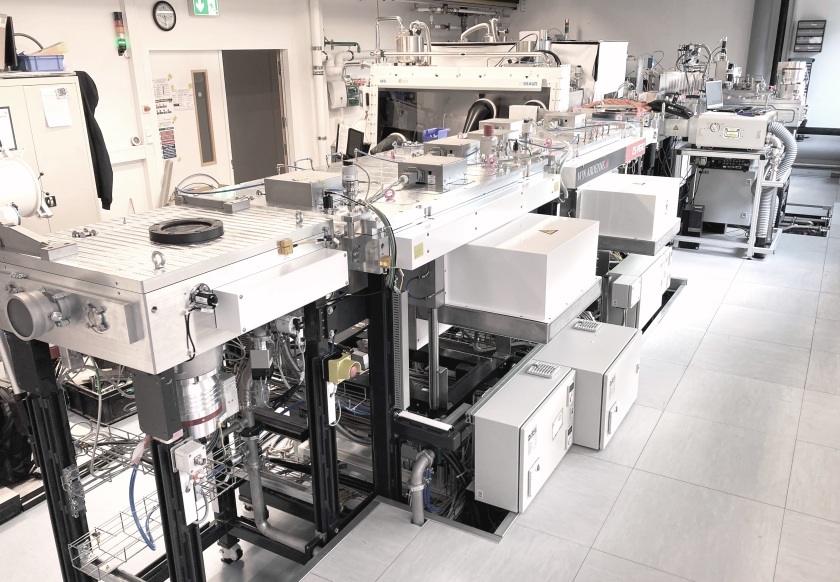On the way to mass production: perovskite silicon tandem cells

The cluster facility operated at HZB allows to produce large-area perovskite/silicon tandem solar cells. This facility, the only one of its kind in the world, helps to develop new industry-related processes, materials and solar cells. © B. Stannowski / HZB
In order to transfer tandem solar cells from laboratory scale to production, HZB is cooperating with the solar module manufacturer Meyer Burger, which has great expertise in heterojunction technology (HJT) for silicon modules. Within the framework of this cooperation, mass production-ready silicon bottom cells based on heterojunction technology are to be combined with a top cell based on perovskite technology.
Meyer Burger is a manufacturer of high-quality solar modules based on silicon heterojunction technology (HJT). Meyer Burger's research and development team has already developed HJT cells in recent years together with Bernd Stannowski's team at the Helmholtz-Zentrum Berlin.
The HZB has great expertise in the field of perovskite solar cells. Recently, laboratory tandem solar cells combining heterojunction and perovskite have achieved record efficiencies of over 31 percent, largely due to the work of Steve Albrecht's group. However, such record-breaking tandem cells have only the laboratory-standard areas of 1 cm² and are partly produced with processes that are not scalable.
"We are therefore delighted to be cooperating with Meyer Burger to transfer this fantastic technology into application," says Bernd Stannowski, who heads the cooperation at HZB. A new cluster facility (KOALA) will also be used. This globally unique facility, funded by the German Federal Ministry of Economics and Climate Protection (BMWK) and the Federal Ministry of Education and Research (BMBF), makes it possible to produce perovskite/silicon tandem solar cells in a vacuum on industry-standard large wafers.
"Meyer Burger manufactures in Europe and thus creates high-quality jobs. In doing so, the company is exploiting technologies that were developed in Europe," says Rutger Schlatmann, director of the Photovoltaics Competence Centre Berlin (PVcomB) at HZB. The new cooperation agreement is set to run for three years.
red.
https://www.helmholtz-berlin.de/pubbin/news_seite?nid=24366;sprache=en
- Copy link
-
Green fabrication of hybrid materials as highly sensitive X-ray detectors
New bismuth-based organic-inorganic hybrid materials show exceptional sensitivity and long-term stability as X-ray detectors, significantly more sensitive than commercial X-ray detectors. In addition, these materials can be produced without solvents by ball milling, a mechanochemical synthesis process that is environmentally friendly and scalable. More sensitive detectors would allow for a reduction in the radiation exposure during X-ray examinations.
-
Electrical energy storage: BAM, HZB, and HU Berlin plan joint Berlin Battery Lab
The Federal Institute for Materials Research and Testing (BAM), the Helmholtz-Zentrum Berlin (HZB), and Humboldt University of Berlin (HU Berlin) have signed a memorandum of understanding (MoU) to establish the Berlin Battery Lab. The lab will pool the expertise of the three institutions to advance the development of sustainable battery technologies. The joint research infrastructure will also be open to industry for pioneering projects in this field.
-
Battery research: visualisation of aging processes operando
Lithium button cells with electrodes made of nickel-manganese-cobalt oxides (NMC) are very powerful. Unfortunately, their capacity decreases over time. Now, for the first time, a team has used a non-destructive method to observe how the elemental composition of the individual layers in a button cell changes during charging cycles. The study, now published in the journal Small, involved teams from the Physikalisch-Technische Bundesanstalt (PTB), the University of Münster, researchers from the SyncLab research group at HZB and the BLiX laboratory at the Technical University of Berlin. Measurements were carried out in the BLiX laboratory and at the BESSY II synchrotron radiation source.
